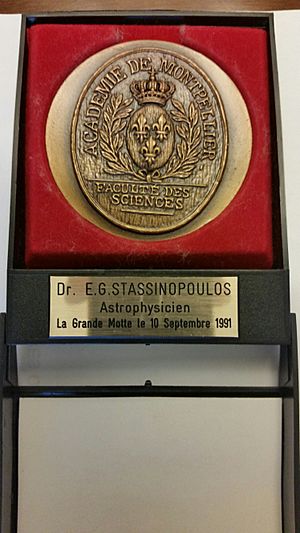Epaminondas Stassinopoulos facts for kids
Epaminondas George Aristotle Alexander Stassinopoulos (born January 17, 1921 – died May 16, 2022) was an American scientist who studied space and radiation. He was born in Germany and later became a member of the Resistance during World War II.
Stassinopoulos worked for the National Aeronautics and Space Administration (NASA) at the Goddard Space Flight Center in Greenbelt, Maryland. He was in charge of the Radiation Physics Office until 2006 and continued as an Emeritus Physicist until 2021. He wrote many important papers and articles about space radiation.
Early Life and Education
Epaminondas Stassinopoulos was born in Bonn, Germany, in 1921. He grew up in Berlin. In 1935, when he was a teenager, he and his older brother were attacked by members of the Hitler Youth. After this, they were sent to Athens, Greece, to escape the dangers of Nazism.
While in Greece, Stassinopoulos joined the Greek resistance movement after the country was occupied by Axis forces in 1941 during World War II. He helped with intelligence work. After the war, he served in the Greek Army during the Greek Civil War from 1946 to 1949. He fought in several battles before studying law. In 1954, he moved to the United States.
Career at NASA
Stassinopoulos joined NASA's Goddard Space Flight Center in 1961. He had studied Mathematics and Physics at The American University and The Catholic University in Washington, DC.
As the head of Goddard's Radiation Physics Office, he studied how radiation in space affects astronauts and spacecraft. His work included:
- Understanding radiation in space.
- Studying how radiation affects living things and electronic systems.
- Creating models to predict radiation levels.
- Designing special facilities to test how things react to radiation.
- Developing tools to measure radiation.
Stassinopoulos led 23 research projects for NASA. He also wrote or co-wrote many scientific papers and articles. He helped start an organization called RADECS in France in 1989, which focuses on how radiation affects electronic parts.
One of his important inventions was a tiny device called the Miniature High-LET Radiation Spectrometer. This small, pill-box-sized instrument weighs less than 90 grams. It can measure different types of radiation in space. He received a US Patent for this invention in 2008. This device has been used on commercial airplanes, the Concorde, and even on the Space Shuttle mission STS-95. His invention is also on the DSCOVR satellite, which was launched in 2015.
After 45 years of working for NASA, Stassinopoulos retired. However, he continued to study space radiation data. When he was 95 years old, he co-authored a NASA publication about changes in a specific radiation area called the "South Atlantic Anomaly." This made him one of the oldest publishing research scientists in NASA's history.
Personal Life and Death
Stassinopoulos married Eftichia "Effie" Pappaioannou on July 16, 1950. She was a scholar who studied languages and ancient cultures. They had one daughter and three grandchildren. Effie passed away in 2013.
Epaminondas Stassinopoulos turned 100 years old in January 2021. He died in Los Angeles on May 16, 2022, at the age of 101.
Awards and Honors
Throughout his career, Stassinopoulos received many awards for his important work. Some of these include:
- The IEEE Radiation Effects Award (2000).
- The APOLLO-XI Achievement Award.
- A medal from the Academie de Montpellier in France.
- The NASA Exceptional Service Medal in 1992.
- The GSFC "Award of Merit" in 1999.


